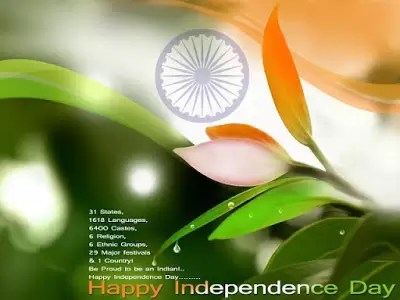Wishing you a very
HAPPY INDEPENDENCE DAY
” We owe a lot to the Indians, who taught us how to count, without which no worthwhile scientific discovery could have been made. “Albert Einstein.
Some Interesting Facts About India
- Indus Valley Civilization is the world’s oldest civilization. So, India is the world’s oldest, most advanced and continuous civilization.
- India has the world’s third largest active army, after China and USA but India has never invaded or attacked a country.
- Today, India is the world’s third largest economy.
- The Tirupati Balaji temple and the Kashi Vishwanath Temple both, receive more visitors than the Vatican City and Mecca combined.
- Every 12 years, a religious gathering called the Kumbh Mela occurs in India. It is the world’s largest gathering of people. The Mahakumbh Mela 2025 saw a record-breaking gathering of over 660 million (66 crore) devotees.
- Varanasi, also known as Benaras, was called “the Ancient City” when Lord Buddha visited it in 500 B.C., and is the oldest, continuously inhabited city in the world today.
- India has third largest Muslim population in the world and has more mosques (300,000 mosques) than any other nation in the world.
- Jews and Christians have lived continuously in India since 200 B.C. and 52 A.D. respectively
- Two major religions, Buddhism and Jainism, were established in India.
- Takshila is said to be the first every university in the world; it started around 700 BC.
- Indian Railways employs more than 1.3 million people. That’s more than the population of many nations.
- India is the largest democracy in the world. More than 54 crore people voted in the 2014 General Election – more people than the population of USA, UK, Australia and Japan combined.
- India has the largest English speaking population in the world.
- India’s space program is one of the top 5 space programs in the world and off course we invented water on the moon.
- The game of chess, originally called Chaturanga, was invented in India during the Gupta Empire around the 6th century CE. It was a strategic board game that emulated military formations.
- And discovered the number zero.
- And the value of pi.
- And trigonometry, algebra, calculus.
- Ayurveda is the earliest school of medicine known to mankind. The Father of Medicine, Charaka, consolidated Ayurveda 2500 years ago.
- The ancient Indian physician Sushruta (c. 6th century BCE) is considered the “Father of Surgery.” His text, the Sushruta Samhita, describes over 300 surgical procedures, including complex operations like rhinoplasty (plastic surgery of the nose) and cataract surgery.
- Around the 17th century, India was one of the richest countries in the world.
- India is one of the only three countries that makes supercomputers (the US and Japan are the other two).
- India has the largest amount of vegetarians in the world. So much so that Pizza Hut had to open their first pure vegetarian restaurant in the country and KFC had to introduce a “vegetarian” menu for India.
- India gave the world Yoga, that has existed for more than 5,000 years.
- Martial Arts was first created in India.
- Shani Shingnapur in Maharashtra has houses without doors or locks, yet residents claim there hasn’t been a theft for centuries, thanks to their strong faith in Lord Shani
- India was the only source of diamonds for nearly 1,000 years, until they were discovered in Brazil in the 18th century.
- The ancient Indian philosopher Kanada (6th century BCE) developed an atomic theory, speculating about the existence of “anu” or small, indestructible particles, centuries before modern scientists like John Dalton.
- The word “shampoo” comes from the Hindi word “chāmpo,” meaning “to massage.” The practice of using a variety of herbs and natural products to clean and massage hair originated in India.
- Ancient texts like the Vedas contain advanced mathematical concepts. The Baudhayana Sutras, for example, describe what is now known as the Pythagorean Theorem centuries before Pythagoras.
- While the Mauryan Empire was a centralized monarchy, ancient Indian states known as Mahajanapadas had forms of republican governance, with elected rulers and councils, centuries before the Roman Republic.
- For over 1,600 years, the Iron Pillar of Delhi has stood without showing any signs of rust. This incredible feat of metallurgy and engineering, dating back to the Gupta Empire, continues to baffle modern scientists and is a testament to the advanced material science of ancient India.
- The name “boson” was coined by physicist Paul Dirac to honor the Indian physicist Satyendra Nath Bose for his work on quantum mechanics and Bose-Einstein statistics. This discovery was a landmark achievement in modern physics.
- The Harappan Civilization was highly skilled in the art of dyeing, with evidence of textiles dyed with vibrant colors like indigo and madder red, which were in high demand for international trade.
- India was the first civilization to produce zinc on an industrial scale. The Zawar mines in Rajasthan were active from the 6th century BCE and featured sophisticated distillation processes to extract the metal.
Proud To Be An Indian
Discover more from Technology with Vivek Johari
Subscribe to get the latest posts sent to your email.





